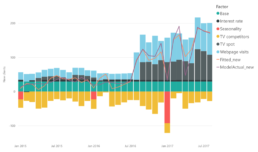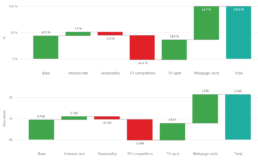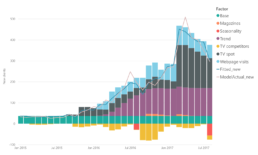Econometrics as a solution to blind spots in your marketing strategy: Grizzlink introduces econometric analysis.
Econometrics as a solution to blind spots in your marketing strategy: Grizzlink introduces econometric analysis.
You have the efficiency of your digital channels sorted thanks to ROI or ROAS, but can’t evaluate the impact of other channels offline? And how to analyse situations where the customers decide to buy your product based on your TV and through Google Ads only finishes the purchase? Based on the ROI in Google Analytics, the impactful channel is Google Ads and TV remains attributeless. Had it not been for it, though, the purchase would’ve never happened. How to approach this?
Grizzlink introduces a product among its analytical services which resolves all these pickles and helps brands make more informed strategic decisions: an econometric analysis.
Up until now, econometrics was mainly the domain of large corporations with deep pockets. Grizzlink strives to level the uneven playing field between David and Goliath and brings this tool not only to large media spenders but also to medium-sized companies whose strategic decisions have been clouded by intelligence blind spots. As with anything in marketing, the econometric analysis should be perceived as an investment, not an expense. Investment improves strategic decision making and strengthens your competitiveness in the long term.
Econometrics?
Econometrics is a field that explains economic relations through the use of economics, mathematics and statistics. It works with datasets worth of historical data, independent and dependent variables. The independent variables include media mix impressions (both you and your competitors), macroeconomic indicators, and other relevant factors; all on the weekly basis. The dependent variable is then business results – most frequently sales, but also a number of leads, store visits etc. To put it simply – the fundamental outcomes of an econometric analysis are the interpretation of the past, streamlining the present and predicting the future. Too ambitious? Read further.
1. Interpretation of the past
Thanks to the analysis of historical activities, we can evaluate which individual channel had the most impact on sales. Without thorough econometric analysis, it is virtually impossible to determine which channels are impactful and to what extent. At the same time, we can detect which channels are simply dead weight ready to be cut out off the media mix. The essential difference between an econometric analysis and an advanced attribution model is that the former does not examine a path to purchase of an individual customer, but works with the whole customer base.
What’s more, we don’t have to limit ourselves to media mix, but we can analyse other factors such as a creative, economic situation or cultural trends. This brings us to the next use of econometric analysis: making the present more effective.
2. More effective present
People best learn from their own mistakes, right? These don’t necessarily have to be mistakes. You could do all the planning by the book but thanks to econometrics you still find out that there is a slightly better split of media for your specific target segment. This way, econometric analysis can save up to 20% of your planned budget and redistribute it for improved effectiveness. Thanks to econometrics the next term will be planned based on real data specific to your segment and your brand. You don’t have to rely on assumptions or best practices for planning anymore.
3. Predicting the future
Thanks to econometrics, you can also predict your key performance indicators based on a specific media mix. Find out what the impact will be if you reallocate 10 % of your media spend to TV campaigns. What the consequences of halting your consumer contests will be. Simultaneously, you will be able to predict the impact of forces outside of your influence which still can have an impact on your business, such as macroeconomic indicators, cultural trends or the impact of weather.
It is noteworthy, however, that all these predictions must be based on historical activities. Although you can foretell the sales volume if you reallocate 10 % of your budget from one channel to another, you cannot predict the impact of adding a new channel, which you haven’t used before.
Case study
Analysis description
- The following case study is an analysis of an anonymous brand within the financial sector. We examine two financial products separately, but also within their mutual relationship across three and a half years with weekly data.
- The goal of the analysis was to determine the factors influencing the acquisition of new clients and to define future managerial recommendations.
- Entry data
- No. of new clients
- Media mix, both the brand’s and its competitors’
- Interest rates, own and the market’s average
- Webpage visits
- Seasonal factors
Main insights
- Media effectiveness: the crucial factors for Product 1 sales are TV campaigns and web visits. As for Product 2, besides TV and web, print ads also contribute to sales.
- Customer journey: TV serves as the first point of contact, builds brand awareness and influences website visits.
- Selection of media: the recommended approach for TV campaigns is to invest GRP between 200-250 for Product 1, and between 400-450 for Product 2.
- ROPO Effect: 1 out of 4 customers looks up Product 1 online, but purchases offline. For Product 2, on the other hand, ¾ of new customers search online and finish purchases in the branch office.
- Spillover effect: the TV campaigns for Product 1 have a positive influence on the number of new customers for Product 2.
- Base line (acquisition of new customers irrespective of marketing activities): Product 2 sees an increasing baseline thanks to long-term TV campaigns. Despite the basic hypothesis, this trend is not apparent for Product 1.
- TV campaigns contribute to webpage visits in 38 % of all cases. Webpage visits contribute to the acquisition of new clients in 63,7 % of cases.
- Carry-over effect (the impact of ads in one month on the customer behaviour in the following month) is at 20 %.
- Optimal Gross Rating Point is between 200 and 250 GRP.
- Increase in the baseline due to TV campaigns has not been detected yet despite the hypothesis built on the strength of TV campaigns.
- Webpage visits contribute to the ROPO effect (searching online, buying offline) in 28,4 % of cases.

- Only competitors’ TV campaigns have a negative influence on the acquisition of new clients.
- Competitors’ communication takes up 46,4 % of potential new clients.

- The number of new clients is affected by TV campaigns, website visits and print ads.
- The TV campaigns for Product 1 have a positive effect on the number of new clients for Product 2 (+67 new clients = 1,5 %).
- Long-term campaigns affect the increasing baseline.
- Long carry-over effect for Product 2 enables longer periods between campaigns (2-3 weeks).
- Ideal Gross Rating Points is between 400 and 450 GRP.
- ROPO Effect is at 78 % – approximately 3 out of 4 new customers search for information online and purchase in the branch store.

- TV campaigns contribute to webpage visits in 38 % of all cases. Webpage visits contribute to the acquisition of new clients in 63,7 % of cases.
- Carry-over effect (the impact of ads in one month on the customer behaviour in the following month) is at 20 %.
- Optimal Gross Rating Point is between 200 and 250 GRP.
- Increase in the baseline due to TV campaigns has not been detected yet despite the hypothesis built on the strength of TV campaigns.
- Webpage visits contribute to the ROPO effect (searching online, buying offline) in 28,4 % of cases.

- Only competitors’ TV campaigns have a negative influence on the acquisition of new clients.
- Competitors’ communication takes up 46,4 % of potential new clients.

- The number of new clients is affected by TV campaigns, website visits and print ads.
- The TV campaigns for Product 1 have a positive effect on the number of new clients for Product 2 (+67 new clients = 1,5 %).
- Long-term campaigns affect the increasing baseline.
- Long carry-over effect for Product 2 enables longer periods between campaigns (2-3 weeks).
- Ideal Gross Rating Points is between 400 and 450 GRP.
- ROPO Effect is at 78 % – approximately 3 out of 4 new customers search for information online and purchase in the branch store.

Warning: Trying to access array offset on false in /www/doc/www.grizzlink.agency/www/wp-content/themes/uncode/partials/elements.php on line 2469
Warning: Trying to access array offset on false in /www/doc/www.grizzlink.agency/www/wp-content/themes/uncode/partials/elements.php on line 2470
Evil digital buzzwords
At times, it may seem that marketing is changing so quickly that what was true yesterday is no longer true today. However, it is really just an illusion. The same way the television or radio are not dead, neither is the consumer of 50+ of age – on the contrary, they are getting stronger and the disproportion between their purchasing power and their use for targeting advertising campaigns is getting weaker. Neither consumption habits nor patterns of buying behavior have died, nor have they fundamentally changed in many respects. The Top Four Dumb buzzwords came into the selection.
#DigitalFirst
Building your marketing strategy on the principle of digital first is like the first page of a detective story to reveal who the killer is. Instead of the word “digital”, mobile, social media and the likes can be less or more confusingly installed.
The choice of strategy and channel occurs only after you have decided which segment you target within the market you operate in and what your brand's position is against the target segment. An honest marketer will first find out what the situation is in a given market/category and if the skeleton is hidden in the supply-side closet. Subsequently, through research, the marketer identifies how a company or brand stands within a given category; prepares a marketing strategy in which he/she decides on what segment will he/she target and how the brand stands against the selected segment. Finally, he/she quantifies marketing goals, an example of a nicely set goal is to increase Brand preferences by 15% in the biomother segment by Q3 2020 and to match it with an estimated increment in sales. Ultimately, the time comes to decide whether and what ad platforms on Google or Facebook will you use.
Jumping on all the new and sparkly is exactly what advertising, in the newspeak parlance “technology”, giants want from the advertisers, but it often has nothing to do with what companies/brands really need.
The strategy, as a result, should be quite simply explainable for non-marketers. However, this does not change the need to make considerable efforts in its creation. The effectiveness of marketing communication, unfortunately, is dropping steadily and dividing communication on digital and non-digital contributes to this. As evidenced by the annual Effie show, the most successful campaigns are those integrated ones, which are based on a marketing strategy.
#Ads
Communication is just one of the components of marketing, and very often the least important one. If you have a quality product, the customer has no problem to get it, and at a price corresponding to quality, quite possibly with no communication bypass. Sure, with good advertising, it will go faster and you will outperform the business plan, but if communication is to compensate for the non-competitive component of the product/price/distribution, you'd better sharpen up. Someone who identifies themselves as a marketing specialist should be able to alert you to any shortcomings and work with them. However, it often happens that when you show your problem to a digital specialist, they suggest you campaigns in Google Ads. If you show the same thing to a social media specialist, they suggest addressing it via Facebook.
Usually, everyone considers themselves a marketing specialist, but not one usually understands anything beyond the servicing of their learned advertising platform. Communication will not save you and if product, price or distribution are getting jammed, the last thing the company needs is communication. Too much attention is being paid to debate over formats and channels. If someone describes themselves as a strategist and with a proud pre-label Digital, Social Media, SEO or PPC, there is no solution to the problem in sight.
So should companies ignore digital advertising? Sometimes yes, sometimes no. It depends on a lot of things that digital specialists don't know they don't know. In presentations from Facebook and Google, they simply don't know much else, and it's often their only marketing awareness. If business doesn't go as planned, communication and digital advertising may not help.
#Lovebrand
Customers do not have an emotional relationship with brands and do not create romantic ideas about them. The vast majority of consumers don't care about brands, and if a majority ceased to exist over night, only 19% of consumers would mind.
Even those brands that are considered to be lovebrands, tend to have a low proportion of their sales generated by the most loyal group of customers. Byron Sharp reports that for the Harley Davidson brand it is less than 10%. The level of loyalty to the brand is then much more significantly linked to market penetration, the larger the market share, the greater the loyalty to the brand. The emotional attachment to the brand didn't change much about the results. The excess of communication activity towards heavy buyers and the neglect of communication towards non-customers then leads to a falling market share.
A classic example of an inappropriate approach to targeting is reaching out to fans on your Facebook page for engagement, which has been refuted many times by Facebook itself.
A strong brand is among the most important goals of and for every marketer and the ultimate mission of advertising is creating strong brands. However, you need to keep your feet firmly on the ground and not to create irrational ideas about the behavior and motivations of customers. Each brand should strive to achieve the highest possible values in standardized brand metrics. Anything beyond that belongs in the realm of illusions.
#ROI
ROI is a metric that gives a nice picture of efficiency. But, as a rule, it provides a poor idea of the effectiveness of marketing endeavors. In terms of approaches, the ROI is equivalent of performance marketing, which generates quick results, gives an illusion of cheapening of the marketing investment, and creates the impression that funds are invested efficiently. Unfortunately, this is only true in the short term. In the long run, both an over-oriented ROI metric and performance marketing are both highways to hell. As anywhere else, a quick and easy way is usually the least suitable. Deciding purely on the basis of ROI metrics leads to short-term goals that will destroy the company and the brand, in the long run.
Is there a light at the end of the tunnel?
Byron Sharp compared the situation in marketing to medicine in the Middle Ages – bloodletting had been a common practice for several centuries. Similarly, today in marketing, practices that do not rely on empirical knowledge are tested, and in the field there are active people who do harm to it and actually do not even have the qualifications for the performance of the profession. On the other hand, companies that don't pop up on buzzwords, understand the marketing craft, and don't get themselves bamboozled, get even better results then. And that's not a bad vision.
When marketing is a cost centre
Or how the marketers became paper salesmen and the key competences on the company direction took over their colleagues from other disciplines.
It happens to the more experienced, too, that we let ourselves manoeuvre into the situation in which we talk about a marketing budget long before it can be defined how much our funny colleagues-marketers contribute to our business target. It originates from the times not long gone when some marketers could dream as they liked, as they had a very little say in key decision making, and every penny, they wished to use to prepare a dinner for key customers, photo shoot or PPC campaign, had to lengthily argue over with the real management.
Transition to zero-based budgeting is stressing, in any case. To wake up one day to find out there isn’t a penny for marketing available. No allocated budget with comfortable cushion for four decent campaign and few small ones. Along with a continual budget for social networks, PPC, graphics, copyrights, CMS, radio and something for smaller productions. And suddenly not a penny more. At least, one can only blame themselves. Finally, to take the plunge and make a long postponed resolution lying in one’s head come true. Also to smash this idea of some colleagues that the company could thrive and grow, even if there were no Facebook, Instagram, Adwords or YouTube.
And outright count with the fact that like all ambitious plans, not all can be done in time, originally dedicated to it. You know, to get the key people from all departments together at company parties and what more, to provoke a little bit of activity in them is no fun. It will happen, after all, in days or more likely in weeks later. By that time, not only a larger part of company roughly knows, but also believes that the marketing has actually quite crucial relevance for company’s functioning. Still, a primary goal is something slightly different. The primary goal is start investing money into the marketing, not spending. In short, to know very well which marketing activity contributes to the business targets which originate from the company’s get-togethers. To plan campaigns with a clear awareness of what leads where and what sense it makes. To define not just in outlines, but with full knowledge of what marketing activity can help the brand metrics, how these brand metrics will in a long-term plan transform into the business results. To establish, along with this all, what marketing channels one uses and what value for money ratio one achieves.
Everyone somewhat guesses how did we get to beforehand planned marketing budgets, back then. Like with many other things, it all comes to the mental laziness, comfiness and laziness, again. To change things, you know, when they work has been always tricky. On the other hand, this is the way how the marketing department becomes a cost centre in the eyes of people from other departments. A centre that delivers on average, consuming resources above average.
And even if we wouldn't mind it for some time, we would find it a little bit sad if we suddenly found ourselves being unwanted, quietly tolerated and sadly insignificant.
So hit it hard and perhaps you’ll find out that the zero-based budget can result in even bigger budget!




